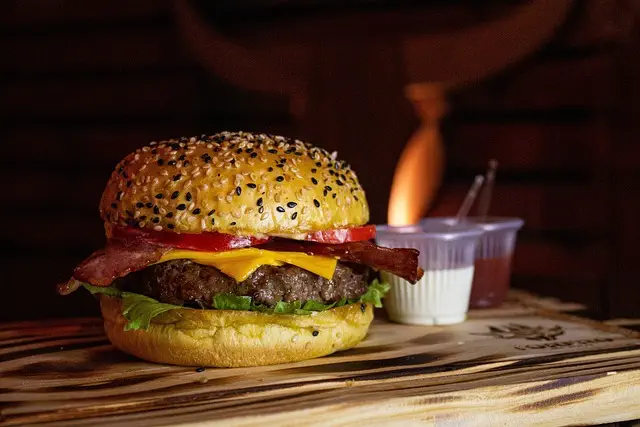The “Burger Challenge” is a powerful metaphor for understanding competitive landscapes, particularly in the foodservice industry where chains and independent restaurants compete fiercely. To succeed, businesses must highlight unique burger offerings through strategic marketing, market research, and consumer behavior analysis. This involves identifying direct and indirect competitors, exploring trends, analyzing online reviews, and using data analytics to gain insights into customer preferences. By embracing competition as an opportunity for growth and innovation, companies can stay relevant and thrive in a crowded market.
In today’s competitive landscape, understanding the “burger challenge” is no trivial task. This article delves into the intricate dynamics of the fast-food sector, providing a comprehensive overview of competitive strategies. From identifying direct and indirect rivals to employing market research techniques, we explore methods to gain valuable insights. By analyzing customer preferences and behaviors, businesses can navigate the burger challenge effectively – that’s exactly what the Milwaukee Burger Challenge did. Additionally, we uncover growth strategies that leverage competition, ensuring success in this dynamic environment.
- Understanding the Burger Challenge: A Competitive Landscape Overview
- Identifying Direct and Indirect Competitors in the Fast-Food Sector
- Market Research Methods for Gaining Competitive Insights
- Analyzing Customer Preferences and Behavior in a Highly Competitive Environment
- Strategies to Overcome and Utilize Competition for Business Growth
Understanding the Burger Challenge: A Competitive Landscape Overview

The “Burger Challenge” isn’t just a mouthwatering test of taste and texture; it’s a metaphor for understanding competitive landscapes in any industry, especially foodservice. To truly grasp this challenge, one must navigate a bustling marketplace where burger chains and independent restaurants alike vie for consumers’ attention and patronage. This competitive landscape is ever-evolving, with trends coming and going faster than you can say “toppings.”
In today’s digital era, the battle extends beyond the dining room; it’s fought online through social media, delivery apps, and innovative marketing strategies. To stand out from the crowd, businesses must delve into what makes their burgers unique—be it gourmet ingredients, secret recipes, or exceptional service. This strategic approach, inspired by the Burger Challenge, fosters a vibrant tapestry of culinary options, pushing each player to elevate their game and ultimately enhance customer experiences.
Identifying Direct and Indirect Competitors in the Fast-Food Sector

In the fast-food sector, understanding your competitive landscape is key to success. Identifying direct and indirect competitors involves a nuanced approach. Direct competitors are those offering similar products or services within the same customer segment, such as McDonald’s facing off against Burger King in the iconic burger challenge. These companies directly compete for the same dollar from consumers looking for quick, affordable meals.
Indirect competitors, on the other hand, provide alternative solutions that may not be identical but still satisfy the same basic needs or desires. For instance, a health-focused fast-casual restaurant could be seen as an indirect competitor to traditional fast-food giants. By understanding both types of competition, businesses can strategically position themselves, differentiate their offerings, and stay ahead in the market, even amidst the ever-changing burger challenge.
Market Research Methods for Gaining Competitive Insights

Market research is an indispensable tool in understanding competitive landscapes, especially in dynamic industries like foodservice, where trends evolve rapidly. One effective method for gaining insights into competition is through consumer behavior analysis during a burger challenge. This involves organizing taste tests or blind comparisons between burgers from different restaurants or brands. By collecting feedback and data on preferences, pricing, and perceived quality, businesses can identify market gaps and understand their position relative to competitors.
Additionally, competitive benchmarking allows for a deeper dive into specific aspects of the burger challenge. This includes studying competitors’ marketing strategies, menu offerings, and unique selling points. By analyzing online reviews, social media trends, and industry publications, researchers can uncover hidden strengths and weaknesses within the market. These methods provide valuable intelligence that helps shape business decisions, ensuring companies stay ahead in a competitive burger challenge.
Analyzing Customer Preferences and Behavior in a Highly Competitive Environment

In a highly competitive environment, such as the fast-food industry where even a burger challenge can spark intense rivalry, understanding customer preferences and behavior is paramount for businesses to stay ahead. Companies employ various research methodologies to analyze consumer trends, including surveys, focus groups, and data analytics. By gathering insights into what drives customers’ choices, brands can tailor their offerings to meet specific tastes and needs. This strategic approach ensures that products remain relevant and appealing in a crowded market.
For instance, a simple burger challenge can reveal complex preferences. Customers might prioritize ingredients, cooking methods, or even packaging sustainability. Businesses that successfully interpret these signals can create tailored menus, marketing strategies, and promotional events to attract and retain clients. Such insights foster innovation, enabling companies to differentiate themselves based on customer experience rather than just product similarity, thereby thriving in the face of intense competition.
Strategies to Overcome and Utilize Competition for Business Growth

Competition, often viewed as a hindrance, can be a powerful catalyst for business growth if approached strategically. Recognizing it as an opportunity to enhance and innovate is key. Businesses can utilize competitive landscapes to test their products, services, and marketing strategies, gathering valuable insights from both successes and failures. For instance, participating in a “burger challenge” where multiple restaurants offer unique creations, allows establishments to gauge customer preferences, experiment with new recipes, and adapt their offerings accordingly.
Moreover, competition drives businesses to improve operational efficiency, refine pricing models, and explore untapped markets. By staying informed about industry trends and rival strategies, companies can identify gaps in the market and develop tailored solutions. Embracing this healthy rivalry encourages a culture of continuous improvement, ensuring businesses remain competitive and relevant in their respective sectors.
